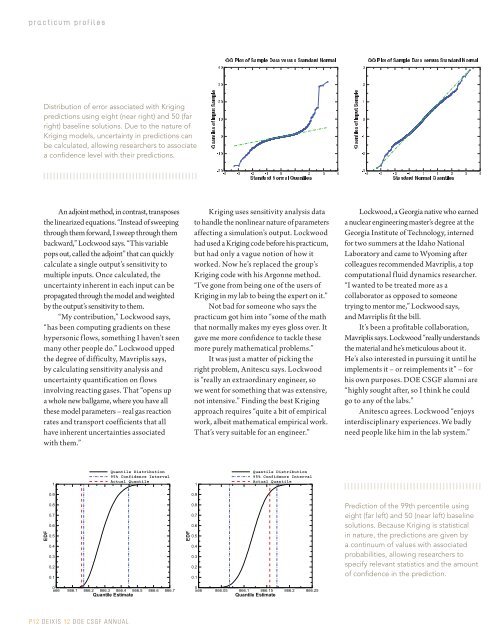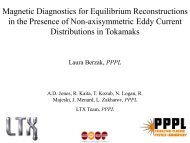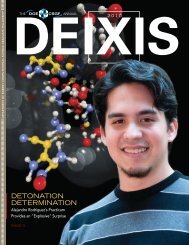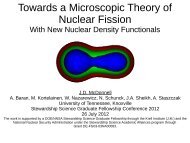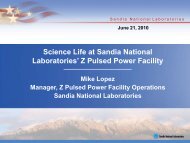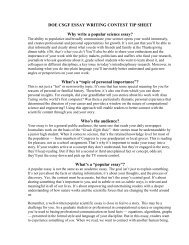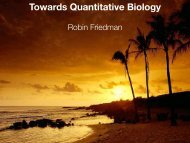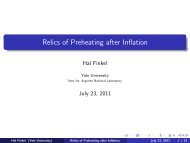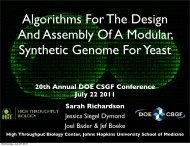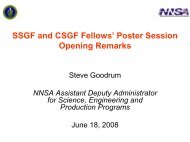2012 - Krell Institute
2012 - Krell Institute
2012 - Krell Institute
You also want an ePaper? Increase the reach of your titles
YUMPU automatically turns print PDFs into web optimized ePapers that Google loves.
practicum profiles<br />
Distribution of error associated with Kriging<br />
predictions using eight (near right) and 50 (far<br />
right) baseline solutions. Due to the nature of<br />
Kriging models, uncertainty in predictions can<br />
be calculated, allowing researchers to associate<br />
a confidence level with their predictions.<br />
An adjoint method, in contrast, transposes<br />
the linearized equations. “Instead of sweeping<br />
through them forward, I sweep through them<br />
backward,” Lockwood says. “This variable<br />
pops out, called the adjoint” that can quickly<br />
calculate a single output’s sensitivity to<br />
multiple inputs. Once calculated, the<br />
uncertainty inherent in each input can be<br />
propagated through the model and weighted<br />
by the output’s sensitivity to them.<br />
“My contribution,” Lockwood says,<br />
“has been computing gradients on these<br />
hypersonic flows, something I haven’t seen<br />
many other people do.” Lockwood upped<br />
the degree of difficulty, Mavriplis says,<br />
by calculating sensitivity analysis and<br />
uncertainty quantification on flows<br />
involving reacting gases. That “opens up<br />
a whole new ballgame, where you have all<br />
these model parameters – real gas reaction<br />
rates and transport coefficients that all<br />
have inherent uncertainties associated<br />
with them.”<br />
Kriging uses sensitivity analysis data<br />
to handle the nonlinear nature of parameters<br />
affecting a simulation’s output. Lockwood<br />
had used a Kriging code before his practicum,<br />
but had only a vague notion of how it<br />
worked. Now he’s replaced the group’s<br />
Kriging code with his Argonne method.<br />
“I’ve gone from being one of the users of<br />
Kriging in my lab to being the expert on it.”<br />
Not bad for someone who says the<br />
practicum got him into “some of the math<br />
that normally makes my eyes gloss over. It<br />
gave me more confidence to tackle these<br />
more purely mathematical problems.”<br />
It was just a matter of picking the<br />
right problem, Anitescu says. Lockwood<br />
is “really an extraordinary engineer, so<br />
we went for something that was extensive,<br />
not intensive.” Finding the best Kriging<br />
approach requires “quite a bit of empirical<br />
work, albeit mathematical empirical work.<br />
That’s very suitable for an engineer.”<br />
Lockwood, a Georgia native who earned<br />
a nuclear engineering master’s degree at the<br />
Georgia <strong>Institute</strong> of Technology, interned<br />
for two summers at the Idaho National<br />
Laboratory and came to Wyoming after<br />
colleagues recommended Mavriplis, a top<br />
computational fluid dynamics researcher.<br />
“I wanted to be treated more as a<br />
collaborator as opposed to someone<br />
trying to mentor me,” Lockwood says,<br />
and Mavriplis fit the bill.<br />
It’s been a profitable collaboration,<br />
Mavriplis says. Lockwood “really understands<br />
the material and he’s meticulous about it.<br />
He’s also interested in pursuing it until he<br />
implements it – or reimplements it” – for<br />
his own purposes. DOE CSGF alumni are<br />
“highly sought after, so I think he could<br />
go to any of the labs.”<br />
Anitescu agrees. Lockwood “enjoys<br />
interdisciplinary experiences. We badly<br />
need people like him in the lab system.”<br />
1<br />
Quantile Distribution<br />
95% Confidence Interval<br />
Actual Quantile<br />
1<br />
Quantile Distribution<br />
95% Confidence Interval<br />
Actual Quantile<br />
EDF<br />
0.9<br />
0.8<br />
0.7<br />
0.6<br />
0.5<br />
0.4<br />
0.3<br />
0.2<br />
0.1<br />
0<br />
866 866.1 866.2 866.3 866.4 866.5 866.6 866.7<br />
Quantile Estimate<br />
EDF<br />
0.9<br />
0.8<br />
0.7<br />
0.6<br />
0.5<br />
0.4<br />
0.3<br />
0.2<br />
0.1<br />
0<br />
866 866.05 866.1 866.15 866.2 866.25<br />
Quantile Estimate<br />
Prediction of the 99th percentile using<br />
eight (far left) and 50 (near left) baseline<br />
solutions. Because Kriging is statistical<br />
in nature, the predictions are given by<br />
a continuum of values with associated<br />
probabilities, allowing researchers to<br />
specify relevant statistics and the amount<br />
of confidence in the prediction.<br />
P12 DEIXIS 12 DOE CSGF ANNUAL


